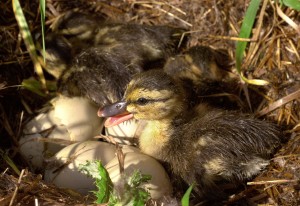BISMARCK, N.D. — North America’s spring duck population is down slightly from record levels, but pond counts are up 24 percent over last year, according to the 2013 Waterfowl Breeding Population and Habitat Survey released today.
The survey, which has been conducted annually since 1955 by the U.S. Fish and Wildlife Service and the Canadian Wildlife service, puts the breeding duck population at 45.6 million, the second-highest level ever recorded.
 “We started with high numbers of breeding ducks, and we have great water in the right places for renesting and duckling survival,” said Frank Rohwer, president of Delta Waterfowl. “Duck production should be excellent.”
“We started with high numbers of breeding ducks, and we have great water in the right places for renesting and duckling survival,” said Frank Rohwer, president of Delta Waterfowl. “Duck production should be excellent.”
Of the 10 species cited in the survey index, only American wigeon and canvasbacks showed an increase from 2012. Wigeon breeding numbers sit at 2.64 million, up 23 percent from 2012 and 2 percent above the long-term average for the species. Canvasbacks showed a modest increase of 4 percent, with the population estimated at 787,000, well above the threshold to have an open season.
“Wigeon, a species which had many folks concerned about a long term decline have now increased two years in a row,” said Joel Brice, vice president of conservation for Delta Waterfowl. “It is nice to see canvasbacks back to near record populations.”
Mallards were at 10.37 million, down 2 percent, but still 36 percent higher than the long-term average. Despite the overall decline, mallards increased locally in the Eastern Dakotas, Southern Manitoba and Southern Saskatchewan.
Gadwalls dipped 7 percent to 3.35 million, but the population remains an impressive 80 percent above the long-term average of 1.86 million.
Northern pintails came in at 3.34 million, a decrease of 4 percent overall. However, pintail numbers increased in southern Saskatchewan and Alberta, a reflection of improved May pond count numbers. Pintails remain 17 percent below the long-term average.
Both blue-winged teal and green-winged teal populations dropped from record levels of 2012. Bluewings are estimated at 7.73 million, a 16 percent decline. However, bluewings are still 60 percent above the long-term average. Greenwings declined 12 percent to 3.05 million, but like bluewings, remain at historically high levels — 51 percent above the long-term average.
“Blue-winged teal, while a decline from last year’s staggering populations are still at extraordinarily high levels,” Rohwer said, acknowledging the USFWS action to increase the bag limit during the early September teal season to six teal daily. “This population, coupled with good water, is good news for hunters chasing bluewings.”
Northern shovelers, another species at record levels in 2012, fell to 4.75 million, a 5 percent decrease. Still, shovelers were found at nearly double the long-term average.
Redheads continue to thrive, coming in at 1.2 million, down 5 percent but still 76 percent above the long-term average.
Scaup — lesser and greater combined — are indexed at 4.17 million, a 20 percent decline and 17 percent below the long-term average. However, scaup are still well above the historic low of 3.3 million in 2006.
Strong Production Expected
May pond counts, an index of wetlands across the survey area, were tallied at 6.89 million, a significant and important 24 percent increase over 2012.
“We started with good water, and it got better with rains in May,” Rohwer said. “All research shows that renesting effort and duckling survival are tied to good water conditions.”
May ponds were up 59 percent in the Eastern Dakotas, 44 percent in Southern Manitoba, 40 percent in Southern Alberta and 6 percent in Southern Saskatchewan.
“Southern Saskatchewan and the Eastern Dakotas are the holy grail for prairie duck production as they hold a very high number of breeding ducks,” Brice said. “This year, duck numbers and wetland conditions are excellent in both places.”
“A number of our staff were concerned in April about the late spring, delayed nesting and a poor frost seal which resulted in poorer than normal run off. However, then the rains came. These rains helped recharge and sustain the small, temporary wetlands that drive duck production. The presence of these wetlands will drive the renesting rate and significantly improve duckling survival.”
Renesting rates are important because many areas of the breeding grounds have poor hatching rates. In drier years, such as 2012, hens that lose a first nest to predators are far less likely to make a new nest and lay more eggs.
“Last year, wetland conditions eroded over the course of the breeding season which is very common, this year conditions improved markedly with spring early summer rains,” Rohwer said. “Our field crews in North Dakota and Manitoba have found renesting ducks, including a gadwall still laying eggs just this week.”
Good production translates into a lot of young ducks.
“Young ducks are far more likely to decoy and respond to calling,” Rohwer said.






